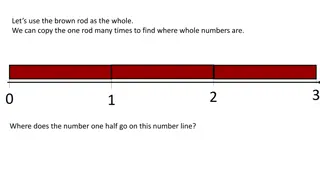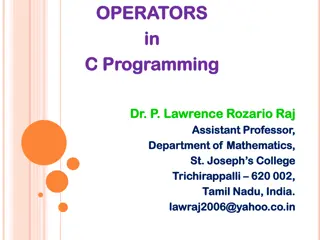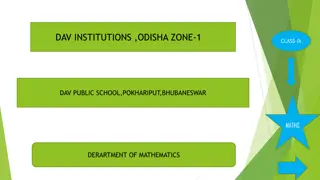Mastering Division: Essential Lessons for Whole Numbers
Explore the fundamental concepts of dividing whole numbers through fact families, two-digit dividends, division patterns, and estimating quotients. Enhance your skills by learning to divide three- and four-digit dividends, interpreting remainders, and more. Dive into these structured lessons to strengthen your division skills efficiently and effectively.
Download Presentation

Please find below an Image/Link to download the presentation.
The content on the website is provided AS IS for your information and personal use only. It may not be sold, licensed, or shared on other websites without obtaining consent from the author.If you encounter any issues during the download, it is possible that the publisher has removed the file from their server.
You are allowed to download the files provided on this website for personal or commercial use, subject to the condition that they are used lawfully. All files are the property of their respective owners.
The content on the website is provided AS IS for your information and personal use only. It may not be sold, licensed, or shared on other websites without obtaining consent from the author.
E N D
Presentation Transcript
CHAPTER 3 Divide Whole Numbers
LESSON 1 RELATE DIVISION TO MULTIPLICATION A fact family is a group of related facts that use the same numbers. You can use fact families to relate multiplication and division. Example: 5 x 4 = 20 4 x 5 = 20 20 5 = 4 20 4 = 5
LESSON 3 TWO-DIGIT DIVIDENDS How to Divide Example 102 6 Think of it as a family: Dad divide Mom multiply Sister subtract Brother bring down next number Rover - remainder _17___ 6 102 - 6 _ 42 - 42_ 0
LESSON 4 DIVISION PATTERNS When dividing, look for a pattern and use the basic fact. 6, 000 30 6 3 = 2 (basic fact) 600 30 = 20 6,000 30 = 200 60 30 = 2 Here s a shortcut subtract the zeros to find out how many zeros are in your answer. 120,000 200 12 2 = 6 (basic fact) 4 2 = 2 zeros in answer 600
LESSON 5 ESTIMATE QUOTIENTS When estimating in division, you use compatible numbers that can divide evenly with no remainders. Example - 541 7 500 7 does not go in evenly. You can change the first two numbers in the dividend to make it work. 490 7 = 70 560 7 = 80 You can also change the divisor. 500 10 = 50 540 6 = 90 There are so many possibilities, but remember it has to go in evenly to be correct. NO REMAINDERS!
LESSON 8 DIVIDE THREE- AND FOUR- DIGIT DIVIDENDS LESSON 10: QUOTIENTS WITH ZEROS For these lessons, review steps of division in lesson 3.
LESSON 12: INTERPRET THE REMAINDER When you solve a division problem with a remainder, the way you interpret the remainder depends on the situation. Example 1 There are 453 people signed up for the sports banquet. If each table seats 9 people, how many tables are needed? 453 9 = 50 r 3 Since 50 table will not be enough to seat everyone, 51 tables will be needed. Example 2 The florist is selling vases for Christmas. Each vase holds 8 flowers. If she has 185 flowers how many vases can she make? 185 8 = 23 r 1 Only 23 complete vases can be made. The 1 flower left over is not enough to make another vase.























